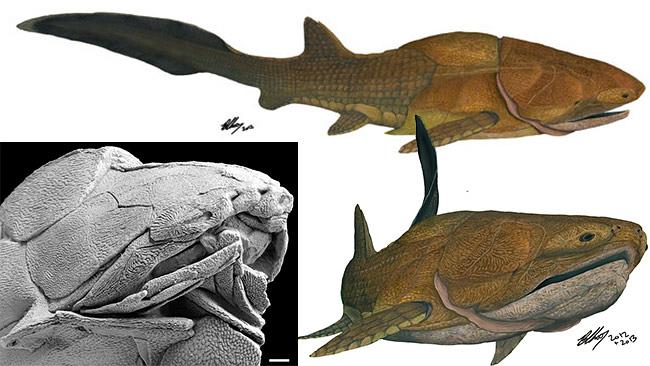A team of paleontologists from China, the United States and Sweden has found a well-preserved fossil of ancient fish that lived in what is now China about 419 million years ago during the Late Silurian period.

Life restoration of Entelognathus primordialis. Image credit: © Brian Choo, gogosardina.deviantart.com.
The fossil has been collected from the Kuanti Formation near Qujing City, Yunnan Province.
The fish, named Entelognathus primordialis, was a 20-cm-long placoderm – an extinct class of armor-plated fishes, the first known animals to evolve true jaws.
Like other placoderms, Entelognathus had armored plates, but it also had more advanced jaw bones – features previously seen only in Osteichthyes (bony fishes).
“The holotype specimen of Entelognathus was found in 2010, however a majority of the specimen was buried in the matrix in the field,” explained Dr Min Zhu from the Institute of Vertebrate Paleontology and Paleoanthropology, Chinese Academy of Sciences, who is a lead author of the paper reporting the discovery in the journal Nature.

Top: a three-dimensionally preserved specimen of Entelognathus primordialis with head and trunk armor in lateral view. Scale bar – 1 cm. Bottom: life restoration of Entelognathus primordialis. Image credit: Min Zhu et al.
“Before its preparation in the laboratory, we had not paid special attention to this specimen.”
Dr Zhu added that the careful lab work in 2011 unveiled its superb preservation for a compelling evidence of an osteichthyan-like marginal jaw bones in a placoderm.
“If the jaws of Entelognathus were not articulated with the skull and trunk armor as many specimens from the same horizon, we probably assign them to an osteichthyan fish.”

According to the paleontologists, the discovery of Entelognathus provides evidence for the evolutionary link between placoderms and bony fishes, and adjusts the understanding of early evolution of gnathostomes (jawed vertebrates).
Source: sci.news









